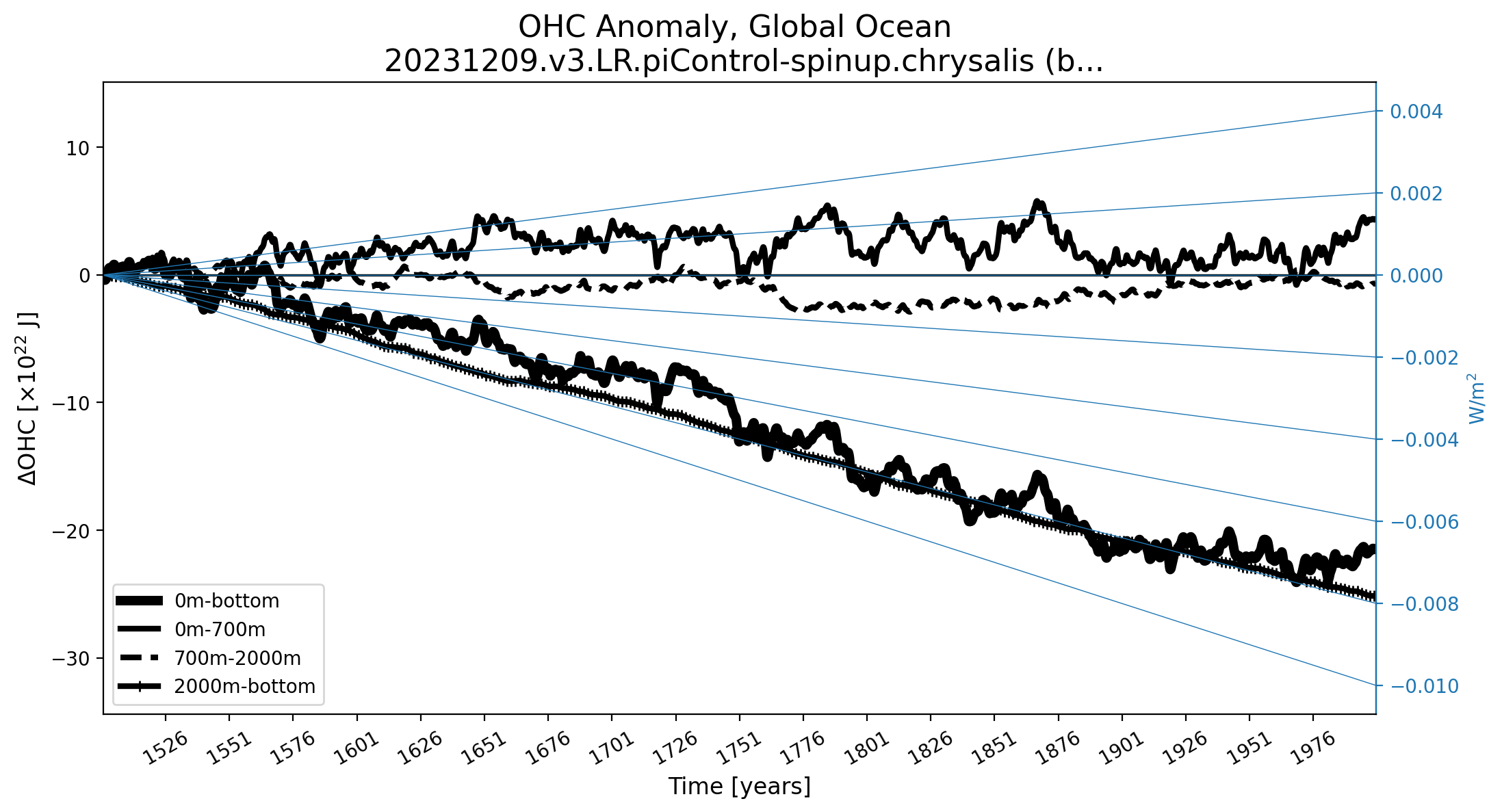E3SMv3 Simulations Underway

Figure 1. Time evolution of the ocean heat content during the last 500 years of the 2000-year v3.LR spin-up simulation. Upper and intermediate water masses (dashed and thin solid lines) have reached a quasi-equilibrium with no long term trend. Bottom water masses and total ocean heat content (thick solid line) is still exhibiting a small cooling trend of a magnitude less than 0.01 W/m2. This drift is acceptable as it is several orders of magnitudes smaller than anthropocentric forcing in the historical period (~ 3 W/m2).
The code base for the lower-resolution configuration of E3SMv3 (“v3.LR”) was tagged on March 4, 2024 (Energy Exascale Earth System Model v3.0.0), a significant milestone for the E3SM Project. E3SMv3 includes many significant advancements from its predecessors such as a much improved simulation of the historical temperature. To note this achievement, the E3SM Coupled Group has put together this article describing E3SMv3 with a focus on the lower resolution configuration v3.LR and the status of the coupled simulation campaign. Other specific advancements will be documented in upcoming v3 overview papers.
v3.LR is the workhorse configuration of the E3SMv3 physical coupled model capable of running simulations spanning thousands of years. Additional configurations with higher resolutions (regionally or globally) are also under development by the Coupled Model Group and will be finalized in the coming year.
The grid spacing for the components in v3.LR is as follows:
- Atmosphere: ~110 km for the dynamics, ~165 km for the physics (same as v2.LR).
- Ocean and sea-ice: An unstructured 21-30km mesh with an icosahedron composite, which represents a substantial resolution increase compared to v2.LR where the grid spacing varied between 30 and 60 km, nearly doubling the grid columns from 236853 to 465044.
- Land and river: common ½ deg regular lat-lon grid. In previous versions, the land was located on the same grid as the atmosphere with the river routing model operating on a ½ deg grid. For v3, a decision was made to have both land and river components on the same grid to facilitate future integration of water management features. As a result, the number of land grid cells increased by over an order of magnitude from 7688 to 94838. A new non-linear higher order remapping was also developed to avoid grid imprinting from the atmosphere to the land.
Since finalization of the v3.LR configuration, the Coupled Model Group has been busy running the associated simulation campaign. We completed a long spin-up (2000 years, Figure 1) followed by the 500-years piControl simulation without a hiccup. The first historical member also ran smoothly. Unfortunately, we encountered unexpected challenges when running the idealized CO2 simulations (abrupt-4xCO2 and 1cptCO2). Both simulations ended up crashing and doing so reliably!
To address the problem, we assembled a sub-group to focus solely on understanding the nature of the instability. The instability manifested itself as extreme mid-depth water temperature up to a month or more preceding model crashes. After several weeks of intense analysis, we found that under ‘hot’ (brought by forced increase of CO2) climate conditions not previously encountered in pre-industrial and historical v3.LR simulations, the ocean baroclinic timestep was too large. We investigated using shorter baroclinic timesteps in the ocean to understand (1) if the model would run stably for ‘hot’ climate simulations, and (2) if we needed to re-run all v3.LR simulations, including the 2000-years spin-up which would have represented a considerable setback for the project.
Fortunately, tests revealed that E3SM’s ocean model can run stably with a 15-minute baroclinic timestep for ‘hot’ climate simulations (instead of the default 30 minutes), and that the climate solution using this configuration does not significantly change a v3.LR historical ensemble member. With this information at hand, the Coupled Group decided to use a reduced ocean time step of 15 minutes only for idealized CO2 simulations, and explain in the v3 overview manuscript why this was necessary. In that paper, we plan to document simulations impacted, demonstrating that changing the ocean time step has a limited effect.
The v3.LR simulation campaign is now back on track and we expect to complete it during the next quarter. This would not have been possible without the dedication of Andrew Roberts, Carolyn Begeman, Jon Wolfe, Luke Van Roekel and Xylar Asay-Davis, who were willing to jump in on a moment’s notice to focus their energy on our instability problem! Thank You!
Contact
- Chris Golaz, Lawrence Livermore National Laboratory,
- Wuyin Lin, Brookhaven National Laboratory
This article is a part of the E3SM “Floating Points” Newsletter, to read the full Newsletter check:


